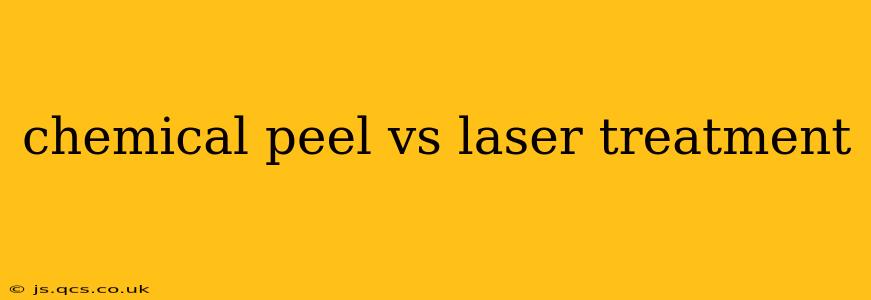Choosing between a chemical peel and laser treatment for skin rejuvenation can feel overwhelming. Both procedures aim to improve skin texture, tone, and reduce the appearance of wrinkles, acne scars, and sun damage, but they achieve this through different mechanisms. Understanding the nuances of each treatment is key to making an informed decision. This comprehensive guide will delve into the specifics of chemical peels and laser treatments, helping you determine which option best suits your individual needs and goals.
What is a Chemical Peel?
A chemical peel involves applying a chemical solution to the skin, causing controlled damage to the outer layers. This controlled injury triggers the skin's natural healing process, resulting in the growth of new, healthier skin cells. The depth of penetration, and therefore the resulting effects, varies depending on the type of chemical used.
There are three main types of chemical peels:
-
Superficial peels: These use mild acids like glycolic acid or salicylic acid and target the epidermis (outermost skin layer). They are ideal for treating mild acne, sun damage, and fine lines. Recovery time is minimal, typically a few days.
-
Medium peels: These utilize stronger acids like trichloroacetic acid (TCA) and penetrate the dermis (middle skin layer). They address more significant issues like moderate acne scarring, age spots, and wrinkles. Recovery time is longer, usually 7-10 days, with some peeling and redness.
-
Deep peels: These employ phenol, the strongest chemical used in peels, reaching deep into the dermis. They are reserved for severe skin damage and wrinkles and have a much longer recovery time, often several weeks, with significant peeling and potential for complications.
What is Laser Treatment?
Laser treatment utilizes highly focused beams of light to target specific skin layers. Different lasers target different skin problems and depths. The heat from the laser stimulates collagen production, resulting in skin tightening, improved texture, and reduced wrinkles, pigmentation, and scarring.
Several types of laser treatments exist, including:
-
Ablative lasers: These lasers remove the outer layers of skin, similar to deep peels, prompting collagen regeneration. They are effective for treating deep wrinkles, scars, and sun damage, but require significant downtime.
-
Non-ablative lasers: These lasers penetrate the deeper layers of skin without removing the surface. They stimulate collagen production with less downtime, suitable for addressing milder skin concerns like fine lines, texture irregularities, and mild pigmentation.
Chemical Peel vs. Laser Treatment: Which is Better for Acne Scars?
The best treatment for acne scars depends on the severity of the scarring. For superficial acne scars, a chemical peel, especially a medium-depth peel, might suffice. Deeper, more pitted scars often benefit from laser treatments like fractional laser resurfacing, which can stimulate collagen production and improve the appearance of the scars.
Chemical Peel vs. Laser Treatment: Which is Better for Wrinkles?
Both chemical peels and laser treatments can address wrinkles, but their effectiveness varies depending on the wrinkle's depth and severity. Superficial peels might help with fine lines, while deeper peels or ablative lasers are better for more pronounced wrinkles. Non-ablative lasers are a good option for those seeking wrinkle reduction with minimal downtime.
How Long Does Recovery Take for Each Treatment?
Recovery time significantly differs between procedures and the depth of treatment. Superficial peels have minimal downtime, with redness subsiding in a few days. Medium peels involve several days of peeling and redness, while deep peels require several weeks of recovery. Laser treatments also have varying downtime depending on the type. Non-ablative lasers typically have minimal downtime, while ablative lasers require several days to weeks of recovery.
What are the Potential Side Effects of Chemical Peels and Laser Treatments?
Both treatments carry potential side effects. Chemical peels can cause redness, peeling, swelling, and hyperpigmentation (darkening of the skin). Laser treatments can also cause redness, swelling, bruising, and blistering, and in rare cases, scarring. It's crucial to discuss potential risks and side effects with a dermatologist before undergoing either procedure.
Which Treatment is More Expensive?
The cost of each treatment varies based on factors like the type of peel or laser, the area treated, and the number of sessions needed. Generally, laser treatments tend to be more expensive than chemical peels.
Conclusion: Choosing the Right Treatment
The decision between a chemical peel and laser treatment is highly individualized and depends on several factors, including your skin type, the severity of the skin concerns, and your desired outcome and recovery time. A thorough consultation with a board-certified dermatologist is crucial to determine which treatment is best suited for your needs. They can assess your skin and recommend the most appropriate and effective approach. Remember, realistic expectations and thorough post-treatment care are key to achieving optimal results.
